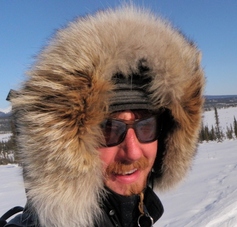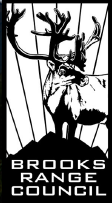The Brooks Range Council formed in the summer of 2012 as it became clear that the Alaska Department of Transportation was rapidly advancing engineering and environmental baseline studies for the road to Ambler. Helicopters carrying survey crews and scientists began appearing regularly in Bettles and elsewhere, working daily to gather data about how and where the road might cross vast wetlands, permafrost, and the 161 rivers and streams in its path. The reality of the situation has become more than simply a theory — we are seeing crews every day now during the field season, and have become more compelled to take action than ever before.
We are composed of stakeholders of all types. While our Chairman has multi-generational roots at Iniakuk Lake, others have the same history at various remote properties, along the Ambler, Kobuk, and Koyukuk Rivers. We have allies within village governments, within the outfitter and guiding community, and we’ve harnessed the technical resources of the conservation community. Our backgrounds and interests are diverse, yet we all agree that this road will cause far more harm than good. Click here to get involved with the BRC and grow with us.
A word from the Chairman
 The justification for industrial development in the Brooks Range is always pitched as a comparison to somewhere else. More jobs, more roads, cheaper fuel, better access and improved quality of life. Compared to what? New York, Los Angeles, Houston? During meetings up here it is rarely a local running the presentations in favor of these things; more often it is a company, based in a big city somewhere far away, representing shareholders who want to extract a resource in order to make profits. If the profit margin is not met, the process accelerates in a frenzy and corrects, or it dies. If the venture fails or environmental disaster occurs, or both, the companies count their losses, change the letterhead, rename the ships and sail on to find profits elsewhere. At the meetings we’re told why these things would be good for us, but I think we should be the ones to make that judgment when so much of our future is at stake.
The justification for industrial development in the Brooks Range is always pitched as a comparison to somewhere else. More jobs, more roads, cheaper fuel, better access and improved quality of life. Compared to what? New York, Los Angeles, Houston? During meetings up here it is rarely a local running the presentations in favor of these things; more often it is a company, based in a big city somewhere far away, representing shareholders who want to extract a resource in order to make profits. If the profit margin is not met, the process accelerates in a frenzy and corrects, or it dies. If the venture fails or environmental disaster occurs, or both, the companies count their losses, change the letterhead, rename the ships and sail on to find profits elsewhere. At the meetings we’re told why these things would be good for us, but I think we should be the ones to make that judgment when so much of our future is at stake.
This approach to large scale mining can, and has, worked well in the places where people are used to the realities of the industry, and there is no doubt that producing minerals is useful to society. But I don’t want the type of jobs offered in New York or the lifestyle available in L.A., and when I travel around this state I don’t meet anyone who does. In cities in the Lower 48 everyone wants to see pictures of Alaska’s vast mountain ranges, clear rivers, secluded fishing holes, migrating herds of caribou, and dog teams traveling for days without encountering roads or people. Not once have I been asked to show a picture of an open pit mine or road. Try wearing a “Made in Alaska” sweatshirt outside the state and see how far you make it before you are randomly stopped to share an experience or story.
I am not proposing that this area is so fragile it should be locked up and never touched. Mining, trapping, hunting and fishing are nothing new to this area, but these things have occurred on a very small scale, over many decades, usually by people who live here. The new mines proposed in the Ambler region — and the infrastructure needed to build them — are enormous by comparison. The issue is far more complex than an isolated large mine in the Brooks Range, however. In this case there are many mine proposals, which would all be connected by roads, have their own power plants, house hundreds of workers and require large amounts of virtually everything needed to run a small city.
Instead, I propose that we treat the wilderness, clean water, fish, and migrating caribou as a resource — a resource we exploit by harvesting food year after year, living within the landscape, and showing it all to others who no longer have, and may never have, such opportunities nearby because they vanished long ago when industrialization came to them. I propose that the Governor and residents of Alaska enjoy the current “roads to resources”; the Koyukuk River, the federally designated Alatna and Kobuk Wild and Scenic Rivers, the Ambler River, and the massive valleys in between — all of which make for good travel in the first place. I believe these places and experiences as we know them are vast and impressive enough to warrant protection from industrialization and justify their safekeeping for future generations both inside and outside Alaska.
Unlike salmon that migrate outside our realm of protection, the Brooks Range is wholly contained inside Alaska. The water and caribou originate here and we will have no excuse when they are polluted or diminished. We bear the responsibility, not just as Alaskans, but as keepers of the Last Frontier. A place aptly named because there is nothing like it left in our country at a scale even remotely comparable. The Alaska state motto is “North to the Future,” suggested by Richard Peter in 1967 who stated, “[It] is a reminder that beyond the horizon of urban clutter there is a Great Land beneath our flag that can provide a new tomorrow for this century’s huddled masses yearning to be free.” The Brooks Range certainly exists beyond the horizon of urban clutter and should be safeguarded as such.
Thank you for stopping by our website. I encourage you to join the Brooks Range Council and help protect this part of Alaska. Feel free to email me with questions as we establish a network of support for our cause.
–John Gaedeke, Iniakuk Lake, July 2012
John Gaedeke is a second-generation Brooks Range guide, raised at Iniakuk Lake and along the Alatna River corridor in the heart of the Brooks Range. He spends half the year at Iniakuk Lake guiding summer hiking, floating, fishing and flight-seeing trips as well as winter dogsled expeditions, day trips, and Northern Lights viewing. The other half of the year he is a carpenter in Fairbanks.

You must be logged in to post a comment.